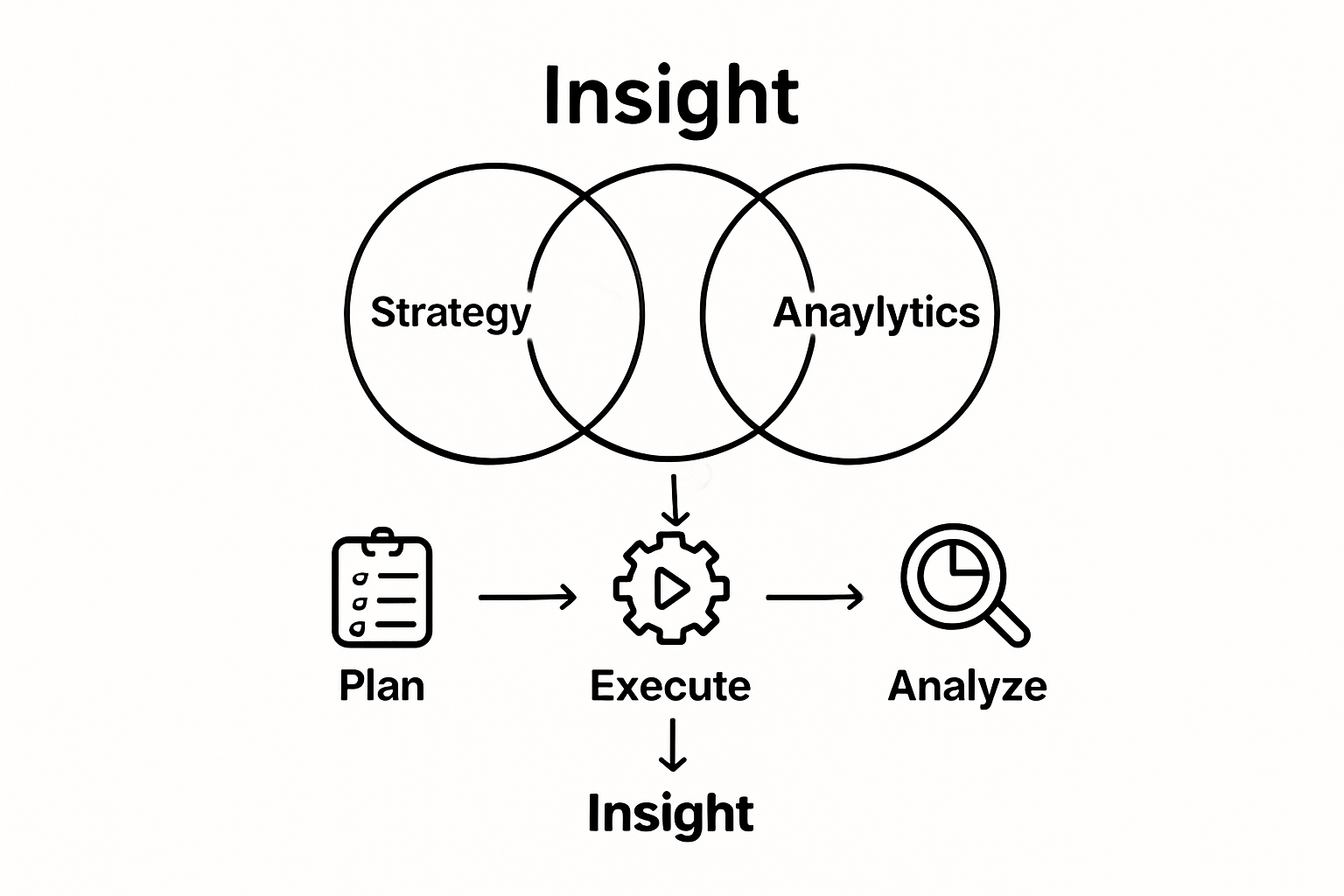
Understanding Collaborating on Marketing Experiments

Marketing experiments used to be solo missions, with each team working in their own corner and sharing little. Yet studies show that organizations practicing collaborative marketing see far more innovative and actionable insights than those sticking to old silos. Sounds like more voices might just complicate things, right? Actually, bringing in different experts turns scattered ideas into powerful strategies and gives experiments an edge few see coming.
Table of Contents
- What Collaborating On Marketing Experiments Means
- The Importance Of Collaboration In Marketing Experiments
- Key Concepts Behind Successful Marketing Collaboration
- How Different Roles Contribute To Marketing Experiments
- Real-World Examples Of Collaboration In Marketing
Quick Summary
| Takeaway | Explanation |
|---|---|
| Collaboration enhances marketing experiments. | Teamwork integrates diverse skills for innovative and insightful marketing solutions. |
| Clear communication is vital for success. | Effective information exchange ensures all team members are aligned on goals and progress. |
| Multidisciplinary teams improve experimental design. | Combining expertise from various fields results in comprehensive strategies and robust methodologies. |
| Fostering a culture of trust boosts creativity. | An environment of psychological safety encourages team members to share ideas and take risks. |
| Collective insights drive better business decisions. | When teams work together to analyze data, they uncover deeper insights that guide strategy development. |
What Collaborating on Marketing Experiments Means
Collaborating on marketing experiments represents a strategic approach where multiple team members, departments, or even external partners work together to design, execute, and analyze experimental marketing initiatives. This collaborative methodology transforms traditional siloed marketing practices into a more integrated, data-driven process.
The Core Principles of Collaborative Experimentation
At its foundation, collaborating on marketing experiments involves breaking down organizational barriers and creating a unified environment where insights, skills, and perspectives converge. Successful collaboration requires a shared commitment to experimentation, where team members from different backgrounds contribute their unique expertise to uncover meaningful marketing insights.
Key characteristics of effective collaborative marketing experiments include:
- Transparent communication across teams
- Shared goals and metrics
- Cross-functional input and analysis
- Comprehensive data collection and interpretation
According to research on collaborative marketing strategies, organizations that foster collaborative experimentation environments tend to generate more innovative and actionable marketing insights compared to traditional competitive approaches.
Multidisciplinary Approach to Experimental Design
Collaborative marketing experiments leverage diverse skill sets and perspectives. A typical collaboration might involve professionals from different domains such as data analytics, creative design, user experience, product management, and customer research. This multidisciplinary approach ensures that experiments are comprehensive, considering multiple dimensions of marketing performance.
By working together, teams can:
- Challenge assumptions more effectively
- Develop more nuanced experimental designs
- Interpret complex data with greater accuracy
- Generate holistic marketing strategies
For marketers looking to dive deeper into collaborative experimentation techniques, our guide on scaling A/B testing efforts provides additional strategic insights into building robust experimental frameworks.
The Importance of Collaboration in Marketing Experiments
Collaboration in marketing experiments transcends traditional team boundaries, representing a strategic approach that amplifies organizational learning, innovation, and decision-making capabilities. By integrating diverse perspectives and expertise, businesses can unlock deeper insights and develop more sophisticated experimental strategies.
Breaking Down Organizational Silos
Collaborative marketing experiments challenge the conventional compartmentalized approach to research and development. When team members from different departments converge, they bring unique viewpoints that challenge existing assumptions and create more comprehensive experimental frameworks. This multidisciplinary interaction enables organizations to:
- Identify blind spots in current marketing strategies
- Generate more holistic experimental designs
- Reduce individual cognitive biases
- Accelerate knowledge transfer across departments
Research from engagement marketing studies demonstrates that collaborative approaches build stronger relationships and transform collective insights into actionable marketing strategies.
Enhancing Experimental Rigor and Validity
Collaboration significantly improves the scientific integrity of marketing experiments. When professionals from various domains like data science, user experience, product management, and creative design collaborate, they introduce multiple layers of scrutiny and validation. This approach ensures that experimental designs are:
- Methodologically sound
- Statistically robust
- Comprehensively analyzed
- Free from single-perspective limitations
By leveraging collective expertise, organizations can develop more nuanced experimental methodologies that capture complex market dynamics. Learn more about advanced experimental strategies with our guide on overcoming A/B testing challenges, which provides deeper insights into collaborative experimentation techniques.
Driving Organizational Learning and Innovation
Collaborative marketing experiments serve as powerful catalysts for continuous organizational learning. When teams share knowledge, challenge each other's perspectives, and collectively interpret results, they create a dynamic learning environment that accelerates innovation. This approach transforms experimental failures from setbacks into valuable learning opportunities, fostering a culture of continuous improvement and adaptive strategy development.
This table summarizes how collaboration enhances marketing experiments by breaking down silos, ensuring rigor, and enabling organizational learning.
| Benefit/Aspect | How Collaboration Makes an Impact |
|---|---|
| Breaks Down Silos | Fosters cross-team knowledge sharing and reduces blind spots |
| Enhances Rigor and Validity | Enables diverse scrutiny and more robust, bias-resistant methodologies |
| Drives Learning & Innovation | Transforms failures into learning, accelerates knowledge transfer |
| Deepens Data Interpretation | Combines perspectives for richer, actionable insights |
| Accelerates Decision-Making | Allows for faster, more confident business decisions |
Key Concepts Behind Successful Marketing Collaboration
Successful marketing collaboration is more than simply bringing team members together it requires a strategic framework that facilitates meaningful interaction, knowledge sharing, and collective problem solving. Understanding the fundamental principles that drive effective collaborative efforts can transform how organizations approach marketing experimentation.
Establishing Clear Communication Protocols
Effective collaboration hinges on transparent and structured communication channels. Organizations must develop robust communication frameworks that enable seamless information exchange across different departments and expertise levels. This involves creating:
- Standardized reporting mechanisms
- Regular cross functional meetings
- Shared digital collaboration platforms
- Transparent documentation processes
According to research on building successful partnerships, proactive engagement and clear communication of project goals are critical for developing strong collaborative relationships.
Cultivating a Shared Experimental Mindset
A collaborative marketing approach requires teams to develop a unified experimental culture that values curiosity, continuous learning, and constructive feedback. This mindset transcends individual departmental objectives and focuses on collective growth. Successful collaborative environments encourage team members to:
- Challenge existing assumptions
- Embrace diverse perspectives
- View failures as learning opportunities
- Prioritize collective insights over individual achievements
To enhance your understanding of analytics and collaboration techniques, explore our guide on choosing analytics tools, which provides deeper insights into technical collaboration strategies.
Building Trust and Psychological Safety
The foundation of any successful collaboration is creating an environment where team members feel safe sharing ideas, admitting mistakes, and proposing innovative solutions. Psychological safety allows professionals to take intellectual risks without fear of ridicule or professional repercussions. Organizations can foster this environment by:
- Promoting a non blame culture
- Recognizing and rewarding collaborative efforts
- Creating structured feedback mechanisms
- Demonstrating leadership commitment to open dialogue
By implementing these key concepts, marketing teams can transform collaborative experiments from theoretical concepts into powerful strategic tools that drive organizational innovation and competitive advantage.

How Different Roles Contribute to Marketing Experiments
Marketing experiments represent a complex ecosystem where diverse professional roles intersect, each contributing unique perspectives and specialized skills that collectively drive comprehensive research and innovation. Understanding how different team members collaborate is crucial for designing robust and insightful experimental strategies.
Strategic Planning and Conceptualization
Marketing leadership and strategic planners play a pivotal role in framing experimental objectives. These professionals establish the overarching goals, align experimental initiatives with broader business strategies, and define the key performance indicators that will measure success. Their contributions include:

- Identifying strategic market opportunities
- Defining clear experimental hypotheses
- Allocating resources and budgets
- Connecting experimental outcomes to organizational objectives
Research on experimental design highlights the critical importance of understanding opportunity costs and potential treatment impacts when deploying marketing experiments.
Technical Execution and Data Analysis
Data scientists and technical analysts form the analytical backbone of marketing experiments. These professionals transform raw data into meaningful insights, employing sophisticated statistical techniques and advanced analytical tools. Their key responsibilities encompass:
- Designing statistically rigorous experimental protocols
- Implementing precise measurement frameworks
- Conducting complex statistical analyses
- Identifying potential biases and statistical anomalies
For deeper insights into experimental optimization techniques, explore our guide on test duration recommendations, which provides advanced strategies for technical experiment management.
Creative and Operational Implementation
Creative professionals and operational teams breathe life into experimental concepts, developing tangible marketing materials and ensuring smooth implementation. Their role involves translating strategic concepts into executable experiments, managing creative assets, and monitoring real world performance. These team members:
- Design experimental creative assets
- Coordinate cross functional communication
- Monitor experimental execution
- Provide qualitative context to quantitative findings
By integrating these diverse roles, organizations can develop comprehensive marketing experiments that combine strategic vision, technical precision, and creative innovation.
Below is a breakdown of the key roles involved in collaborative marketing experiments and their primary contributions at each stage.
| Role | Main Contributions |
|---|---|
| Strategic Planners/Leadership | Set goals, align experiments with organizational strategy, define KPIs, allocate resources |
| Data Scientists/Analysts | Design rigorous protocols, perform statistical analysis, detect biases, analyze results |
| Creative Professionals | Develop marketing assets, translate concepts into campaigns, provide creative insights |
| Operational Teams | Coordinate implementation, manage logistics, monitor experiment execution, report on progress |
| Customer Insights/UX Teams | Provide user feedback, inform hypothesis development, interpret customer responses |
| Sales Teams | Share frontline insights, relay customer feedback, inform market positioning |
Real-World Examples of Collaboration in Marketing
Collaboration in marketing transcends theoretical concepts, manifesting in powerful real-world scenarios where diverse teams unite to solve complex challenges and drive innovative solutions. These practical examples demonstrate how integrated efforts can generate transformative marketing insights and strategies.
Interdepartmental Product Launch Collaboration
Marketing teams often collaborate extensively during product launch initiatives, requiring seamless coordination between multiple organizational departments. Successful product launches exemplify how cross functional collaboration can amplify marketing effectiveness. Typical collaborative scenarios involve:
- Research and development sharing technical product specifications
- Design teams creating compelling visual narratives
- Customer insights teams providing market positioning recommendations
- Sales teams offering frontline customer feedback
Research highlighting collaborative marketing dynamics underscores the importance of integrated approaches in developing comprehensive marketing strategies.
Digital Campaign Optimization Partnerships
Digital marketing campaigns represent another arena where collaborative efforts yield significant benefits. Multidisciplinary teams work together to design, execute, and refine complex digital marketing initiatives. These collaborations typically involve:
- Data scientists analyzing user interaction patterns
- Creative professionals developing engaging content
- Performance marketing specialists tracking campaign metrics
- User experience designers optimizing conversion pathways
For more insights into effective test data utilization, explore our comprehensive guide, which provides advanced strategies for collaborative digital marketing experiments.
Academic and Industry Research Collaborations
Some of the most innovative marketing experiments emerge from strategic partnerships between academic institutions and industry organizations. These collaborations combine theoretical research frameworks with practical business applications, generating unique insights that drive marketing innovation. Key characteristics of such partnerships include:
- Shared research objectives
- Complementary expertise
- Access to diverse data sources
- Rigorous methodological approaches
By embracing collaborative approaches, organizations can transform marketing experiments from isolated activities into powerful engines of strategic innovation and continuous learning.
Unlock Effortless Collaboration in Your Marketing Experiments
Are you finding it hard to break down silos and make your marketing experiments truly collaborative? The article highlighted the challenge of uniting different roles and expertise to achieve shared goals, rigorous data collection, and actionable insights. If coordinating teams, standardizing reporting, and making fast, confident decisions feel overwhelming, it is time for a smarter solution.

Experience how Stellar takes collaboration to the next level. Quickly set up experiments with a no-code visual editor, bring cross-functional teams together with dynamic keyword insertion, and make data-driven choices in real time with advanced goal tracking. Move from isolated tests to powerful results your whole team can get behind. Ready for a more streamlined and connected approach? Visit the Stellar homepage now and see how easily you can build a culture of insight and innovation.
Frequently Asked Questions
What does collaborating on marketing experiments involve?
Collaborating on marketing experiments involves working together across multiple teams or departments to design, execute, and analyze marketing initiatives, breaking down traditional silos for a more integrated approach.
Why is collaboration important in marketing experiments?
Collaboration enhances organizational learning, innovation, and decision-making by integrating diverse perspectives, which leads to more comprehensive experimental strategies and deeper insights.
How can different roles contribute to marketing experiments?
Different roles, including strategic planners, data analysts, and creative professionals, each contribute unique insights and skills that combine to develop robust marketing experiments across various stages of execution and analysis.
What are the benefits of a multidisciplinary approach in marketing experimentation?
A multidisciplinary approach allows teams to challenge assumptions, develop nuanced designs, and interpret complex data accurately, ultimately leading to more innovative and effective marketing strategies.
Recommended
- Overcoming A/B Testing Challenges: Strategies for 2025
- Scaling A/B Testing Efforts: Proven Strategies for 2025
- Experiment Experimentation: Praxiswissen für CRO und Marketing 2025
- Advanced A/B Testing Strategies for CRO Marketers in 2025
- Mastering the Product Marketing Approach: Proven Strategies to Elevate Your Brand
Published: 9/26/2025